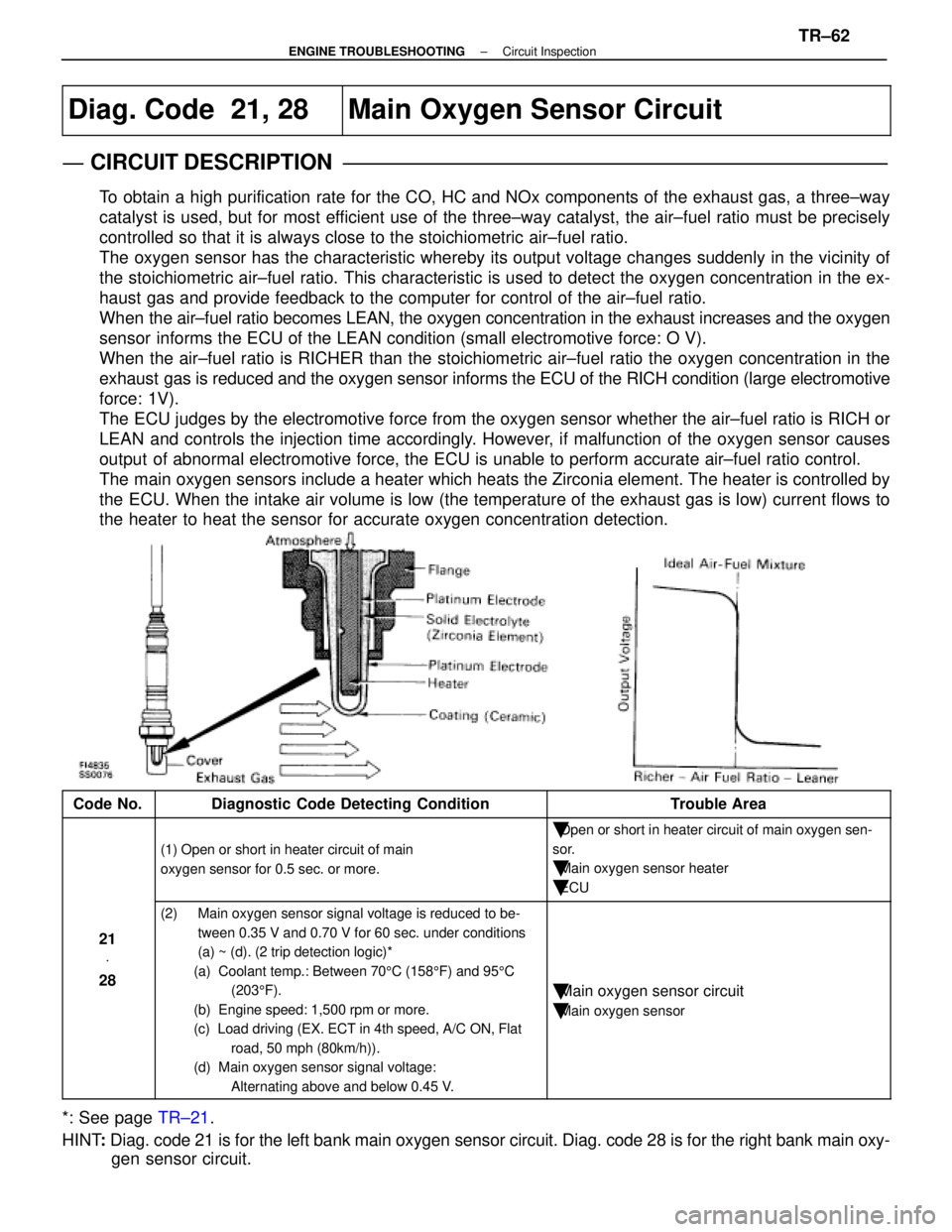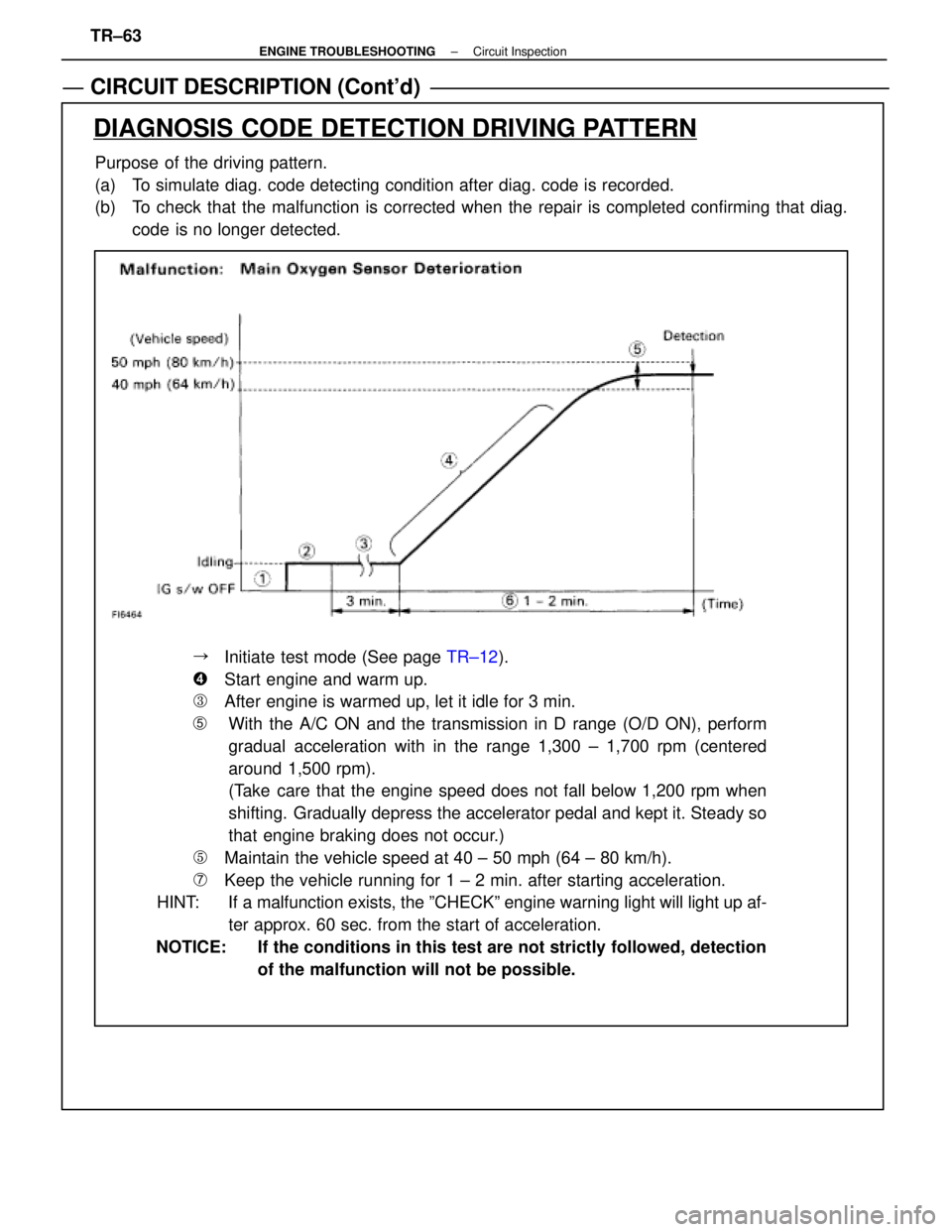Page 2668 of 4087
OKNG
OKNG
4Check voltage between terminals IGT1, 2 of engine and & ECT ECU connector and body ground.
C
OK
PConnect the Check Harness A.
(See page TR±30).
Measure voltage between terminals IGT1, 2 of engine
& ECT ECU connector and body ground when engine
is cranked.
Voltage: 0.5 ± 1.0 V (Neither 0 V nor 5 V)
Go to step [9].
5Check voltage between terminal 3 of No. 1, No. 2 igniter connectors and \
body ground.
C
OK
PDisconnect igniter connector.
Mesure voltage between terminal 3 of No. 1, No. 2 igni-
ter connectors and body ground, when ignitino switch is
turned to ªONº and ªSTAº position.
Voltage: 10 ± 14 V
Go to step [8].
±
ENGINE TROUBLESHOOTING Circuit InspectionTR±57
WhereEverybodyKnowsYourName
Page 2669 of 4087
OKNG
OKNG
6Check for open and short in harness and connector between ignition relay and \
ignition coil,
ignition coil and igniter (See page IN±27).
Repair or replace harness or connector
#Check ignition coil.
C
OK
PDisconnect ignition coil connector.
(For No. 1 ignition coil (on left bank), remove the battery)
(2) Check primary coil. Measure resistance between terminals of ignition
coil connector.
(2) Check secondary coil. Measure resistance between terminal 1 of ignition
coil connector and high±tension terminal.
Replace ignition coil.
Replace Igniter. *1
*1: When diag. code 14 is displayed, replace the igniter with 5 wire harness. (extra wire is for tachometer). When diag.
code 15 is displayed, replace the igniter with 4 wire har-
ness
TR±58±
ENGINE TROUBLESHOOTING Circuit Inspection
WhereEverybodyKnowsYourName
Page 2670 of 4087
OKNG
8Check Ignition Relay.
C
OK
P
C
OK
Remove ignition relay.
Check continuity between terminals of ignition relay
shown below.
(2) Apply battery voltage between terminals 3 and 6, 4and 5.
(2) Check continuity between terminals 1 and 2.
Replace ignition relay.
Check and repair harness or connector between
battery and ignition relay, ignition relay and igni-
ter.
±
ENGINE TROUBLESHOOTING Circuit InspectionTR±59
WhereEverybodyKnowsYourName
Page 2671 of 4087
NGOK
OKNG
9Disconnect igniter connector and check voltage between terminals IGT1, 2 of engine & ECT
ECU connector and body ground.
C
OK
PDisconnect igniter connector.
Connect engine & ECT ECU connector.
Measure voltage between terminals IGT1, 2 of engine
& ECT ECU connector and body ground when engine
is cranked.
Voltage: 0.5 ± 1.0 V(Neither 0 V nor 5 V)
Replace igniter .*1
10Check for Open and short in harness and connector in IGT signal circuit betwee\
n engine & ECT
ECU and igniter (See page IN±27).
Repair or replace harness or connector.
Check and replace engine & ECT ECU.
*1: When diag. code 14 is displayed, replace the igniter with 5 wire harness. (extra wire is for tachometer). When diag.
code 15 is displayed, replace the igniter with 4 wire har-
ness
TR±60±
ENGINE TROUBLESHOOTING Circuit Inspection
WhereEverybodyKnowsYourName
Page 2672 of 4087
Diag. Code 16ECT Control Signal Malfunction
CIRCUIT DESCRIPTION
The signal from the ECT CPU retards the ignition timeing of the engine duri\
ng ECT gear shifting, thus mo-
mentarily reducing torque output of the engine for smooth clutch operati\
on inside the transmission and re-
duced shift shock.
Code No.Diagnostic Code Detecting ConditionTrouble Area
16Fault in communications between the engine
CPU and ECT CPU in the ECU.�ECU
If the ECU records the diagnostic code ª16º in memory, it prohibits the torque control of the ECT which per-
forms smooth gear shifting.
DIAGNOSTIC CHARTDIAGNOSTIC CHART
Are there any other codes (besides Code 16)
being output?
Replace engine & ECT ECU. Go to relevant diag. code chart.
±
ENGINE TROUBLESHOOTING Circuit InspectionTR±61
WhereEverybodyKnowsYourName
Page 2673 of 4087

Diag. Code 21, 28Main Oxygen Sensor Circuit
CIRCUIT DESCRIPTION
To obtain a high purification rate for the CO, HC and NOx components of th\
e exhaust gas, a three±way
catalyst is used, but for most efficient use of the three±way catalyst, the air±fuel ratio must be \
precisely
controlled so that it is always close to the stoichiometric air±fuel \
ratio.
The oxygen sensor has the characteristic whereby its output voltage chan\
ges suddenly in the vicinity of
the stoichiometric air±fuel ratio. This characteristic is used to det\
ect the oxygen concentration in the ex-
haust gas and provide feedback to the computer for control of the air±\
fuel ratio.
When the air±fuel ratio becomes LEAN, the oxygen concentration in the exh\
aust increases and the oxygen
sensor informs the ECU of the LEAN condition (small electromotive force: O V)\
.
When the air±fuel ratio is RICHER than the stoichiometric air±fuel\
ratio the oxygen concentration in the
exhaust gas is reduced and the oxygen sensor informs the ECU of the RICH condition (large electromotive
force: 1V).
The ECU judges by the electromotive force from the oxygen sensor whether th\
e air±fuel ratio is RICH or
LEAN and controls the injection time accordingly. However, if malfunction of the oxygen sensor causes
output of abnormal electromotive force, the ECU is unable to perform accurate \
air±fuel ratio control.
The main oxygen sensors include a heater which heats the Zirconia element. The heater is controlled by
the ECU. When the intake air volume is low (the temperature of the exhaust\
gas is low) current flows to
the heater to heat the sensor for accurate oxygen concentration detectio\
n.
Code No.Diagnostic Code Detecting ConditionTrouble Area
(1) Open or short in heater circuit of main
oxygen sensor for 0.5 sec. or more.
�Open or short in heater circuit of main oxygen sen-
sor.
�Main oxygen sensor heater
�ECU
21 V
28
(2) Main oxygen sensor signal voltage is reduced to be-
tween 0.35 V and 0.70 V for 60 sec. under conditions
(a) ~ (d). (2 trip detection logic)*
(a) Coolant temp.: Between 70 5C (158 5F) and 95 5C
(203 5F).
(b) Engine speed: 1,500 rpm or more.
(c) Load driving (EX. ECT in 4th speed, A/C ON, Flat road, 50 mph (80km/h)).
(d) Main oxygen sensor signal voltage:
Alternating above and below 0.45 V.
�Main oxygen sensor circuit
�Main oxygen sensor
*: See page TR±21.
HINT : Diag. code 21 is for the left bank main oxygen sensor circuit. Diag. co\
de 28 is for the right bank main oxy-
gen sensor circuit.
±
ENGINE TROUBLESHOOTING Circuit InspectionTR±62
WhereEverybodyKnowsYourName
Page 2674 of 4087

CIRCUIT DESCRIPTION (Cont'd)
Purpose of the driving pattern.
(a) To simulate diag. code detecting condition after diag. code is recorded.
(b) To check that the malfunction is corrected when the repair is completed confirming that diag.code is no longer detected.
DIAGNOSIS CODE DETECTION DRIVING PATTERN
��Initiate test mode (See page TR±12).
��Start engine and warm up.
��After engine is warmed up, let it idle for 3 min.
�With the A/C ON and the transmission in D range (O/D ON), perform
gradual acceleration with in the range 1,300 ± 1,700 rpm (centered
around 1,500 rpm).
(Take care that the engine speed does not fall below 1,200 rpm when
shifting. Gradually depress the accelerator pedal and kept it. Steady so
that engine braking does not occur.)
��Maintain the vehicle speed at 40 ± 50 mph (64 ± 80 km/h).
��Keep the vehicle running for 1 ± 2 min. after starting acceleration.
HINT: If a malfunction exists, the ºCHECKº engine warning light will light\
up af-
ter approx. 60 sec. from the start of acceleration.
NOTICE: If the conditions in this test are not strictly followed, detection of the malfunction will not be possible.
TR±63
±
ENGINE TROUBLESHOOTING Circuit Inspection
WhereEverybodyKnowsYourName
Page 2675 of 4087
DIAGNOSTIC CHART
DIAGNOSTIC
CHART
WIRING DIAGRAM
HINT: If diag. code º21º is output, check the left bank main oxygen sens\
or circuit. If diag. code º28º is output, check the right bank main oxygen sensor circuit.
Check voltage of terminals HTL1, HTR1.
Check resistance of oxygen sensor heater.
Check and repair oxygen sensor heater circuit.
Check operation of oxygen sensor heater.
Check and replace ECU. Replace main oxygen sensor.
*: In this case, oxygen sensor can be deteriorated.
Replace main oxygen sensor.*
±
ENGINE TROUBLESHOOTING Circuit InspectionTR±64
WhereEverybodyKnowsYourName